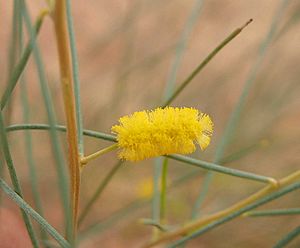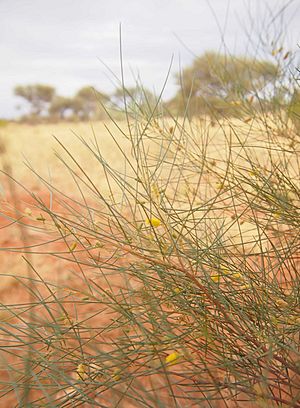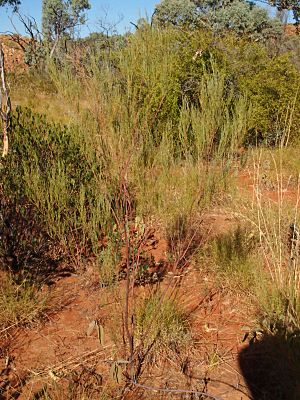Narrow-leaved wattle
Quick facts for kids Narrow-leaved wattle |
|
|---|---|
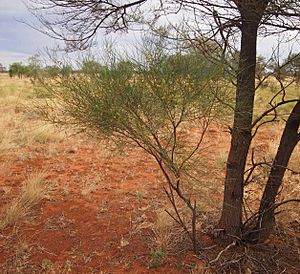 |
|
| A. tenuissima habitat | |
| Scientific classification | |
| Genus: |
Acacia
|
| Species: |
tenuissima
|
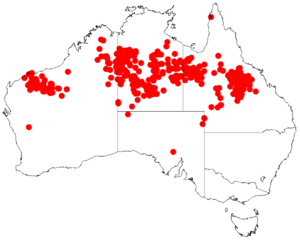 |
|
| Occurrence data from AVH | |
Acacia tenuissima, also known as the narrow-leaved wattle or broom wattle, is a cool shrub found in Australia. It belongs to the large Acacia plant family. Indigenous Australians, like the Kurrama and Banyjima peoples, have their own names for it: Janangungu and Murruthurru.
Contents
What Does It Look Like?
This slender shrub usually grows about 1 to 3 meters (3 to 10 feet) tall. Sometimes, it can even reach up to 4 meters (13 feet)! It often has many thin stems growing from the ground. These stems create an open or bushy top. The bark is smooth and grey at the bottom, turning pale brown or reddish on the upper branches.
Its leaves are quite unique. They are dull grey-green and very thin, like needles. These special leaves are called phyllodes. They can be 6 to 17 centimeters (2 to 7 inches) long and less than 2 millimeters (0.08 inches) wide. They have many fine lines running along them.
The plant blooms with yellow flowers from April to August. Its flowers grow in spikes, which are a type of inflorescence (a cluster of flowers). These spikes are 5 to 15 millimeters (0.2 to 0.6 inches) long. They are packed with pale yellow to light golden flowers.
After the flowers, greyish-brown seed pods form. These pods can be straight or slightly curved. They might also become twisted or scaly as they get older. The pods can grow up to 9 centimeters (3.5 inches) long. Inside, they hold shiny dark brown to black seeds.
The seeds are about 2.5 to 4 millimeters (0.1 to 0.16 inches) long and 2 millimeters (0.08 inches) wide. They are quite big and have a bright orange-to-yellow aril. An aril is a fleshy covering that attracts birds. Birds help spread the seeds around. New seeds are ready between September and November.
This wattle looks a bit like Acacia orthocarpa. It is also similar to Acacia exilis and Acacia macdonnelliensis subsp. teretifolia.
How It Got Its Name
The Acacia tenuissima was first officially described in 1859. A botanist named Ferdinand von Mueller gave it its scientific name. He wrote about it in a science journal.
Later, in 1987, another botanist, Leslie Pedley, changed its name to Racosperma tenuissimum. But in 2006, it was moved back to the Acacia family.
The name tenuissima comes from Latin words. Tenuis means "thin" and -issimus means "very." So, tenuissima means "very thin." This name describes its slender, needle-like leaves perfectly!
A. tenuissima is sometimes found growing near Acacia adsurgens. They are also closely related to each other. It is also related to Acacia exilis.
Where Does It Grow?
This wattle is found in dry, inland parts of Australia. In South Australia, it grows in the northwest. A smaller group also lives around Lake Eyre in the east. You can find it throughout central and southern parts of the Northern Territory. It also grows in central Queensland.
It is also scattered across the Kimberley and Pilbara regions of Western Australia. You often see it along temporary rivers or streams. It also likes low, rolling hills, rocky slopes, and sandy plains. It can grow in sandy, loamy, clay, and rocky soils.
This plant usually grows in Eucalyptus woodlands. It is often found with spinifex grasses.
Growing and Using This Wattle
You can buy seeds for Acacia tenuissima. It makes a nice, slender shrub for gardens in dry areas. It is also great for attracting birds. To grow well, it needs a sunny spot and soil that drains water easily.
Before planting, the seeds need a special treatment. This might involve scratching them or soaking them in hot water. This helps them sprout.
Indigenous Australians from the Pilbara region used to collect these seeds. They would eat them or use them to make damper, a traditional bread.


